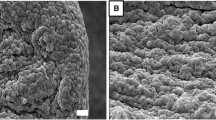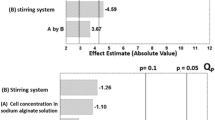Abstract
Schizosaccharomyces yeasts can be used for deacidification of grape musts. To this aim, we studied malic acid degradation by yeasts included in double layer alginate beads in a bubble column reactor. Use of immobilized micro-organisms allowed a continuous process with high dilution rates giving a deacidification capacity of 0.032 g of malate/hour/dm3/g of beads. The pneumatic agitation was very convenient in this case.
Similar content being viewed by others
Abbreviations
- D h−1 :
-
Dilution rate for continuous culture
- τ h:
-
Residence time for continuous culture
- dM/dt kg/(m3 · h):
-
Rate of degradation of malic acid
- dS/dt kg/(m3 · h):
-
Rate of consumption of glucose
- μ max h−1 :
-
Maximal specific rate of growth
References
Lodder, J.: The yeasts. A taxonomic study. 2nd Edition, 733–755. North Holland, Pub. Co: Amsterdam, London, 1970
Taillandier, P.; Riba, J. P.; Strehaiano, P.: Malate utilisation by Schizosaccharomyces pombe. Biotech. Lett. 10, 7 (1988) 469–472
Margaritis, A.; Merchant, F. J. A.: Advances in ethanol production using immobilized cells system. CRC Crit. Rev. Biotechnol. 1, 4 (1984) 339–393
Auriol, P.; Tulasi, S.; Goma, G.; Strehaiano, P.: Désacidification par Schizosaccharomyces. Etude sur les aptitudes de différentes souches. Approche cinétique sur la dégradation de l'acide malique. Rev. Fr. Oenol. 108 (1987) 37–42
Ogbonna, J. C.; Amanoy, Y.; Nakamura, K.: Elucidation of optimal conditions for immobilization of viable cells using Caalginate. J. Ferm. Bioeng. 67, 2 (1989) 92–96
Spetolli, P.; Bottacin, A.; Nuti, M. P.; Zamorani, A.: Immobilization of Leuconostoc oenos ML 34 in Ca-alginate gels and its application to wine technology. Am. J. Enol. Vitic. 30, 1 (1982) 45–48
Tanaka, T.; Yamamoto, K.; Towprayoon, S.; Nakajima, H.; Sonomoto, K.; Yokozeki, K.; Kubota, K.; Tanaka, A.: Continuous production of 1-serine by immobilized growing Corynebacterium glycinophylum cells. Appl. Microbiol. Biotechnol. 30 (1989) 564–568
Zache, G.; Rhem, H. J.: Degradation of phenol by a co-immobilized entrapped mixed culture. Appl. Microbiol. Biotechnol. 30 (1989) 426–432
Yang, H. D.; Hamanci, H.; Woodams, E. E.: Production of 1-lactic acid by Rhizopus oryzae immobilized in Ca-alginate gels. Biotech. Lett. 11, 2 (1989) 119–120
Hannoun, J. M.; Stephanopoulos, G.: Diffusion coefficients of glucose and ethanol in cell-free and cell-occupied Ca-alginate membrane. Biotech. Bioeng. 28 (1989) 829–835
Gosmann, B.; Rhem, H. J.: Influence of growth behavior and physiology of alginate entrapped micro-organism on the oxygen consumption. Appl. Microbiol. Biotechnol. 29 (1988) 554–559
Santos-Rosa, F.; Ganvan, F.; Vega, J. M.: Biological viability of Chlamidomonas reinhartii cells entrapped in alginate beads for ammonium photoproduction. J. Biotechnol. (1989) 209–220
Mori, A.; Matsumoto, N.; Imai, C.: Growth behaviour of immobilized acetic acid bacteria. Biotech. Lett. 11, 3 (1989) 183–188
Author information
Authors and Affiliations
Rights and permissions
About this article
Cite this article
Taillandier, P., Riba, J.P. & Strehaiano, P. Malate degradation by Schizosaccharomyces yeasts included in alginate beads. Bioprocess Engineering 7, 141–144 (1991). https://doi.org/10.1007/BF00369426
Received:
Issue Date:
DOI: https://doi.org/10.1007/BF00369426




